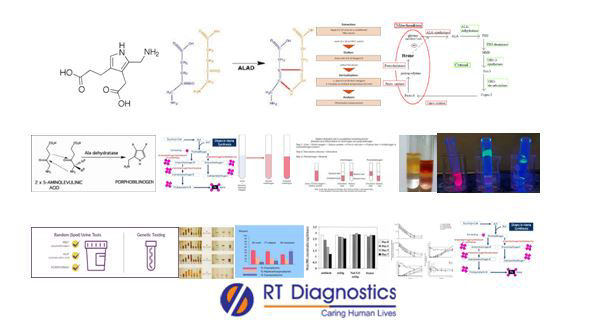Porphobilinogen:
Why Porphobilinogen Test?
CLINICAL INFORMATION
Porphine is the parent of porphyrin. Porphyrins are a group of heterocyclic macrocyclic organic compounds composed of 4 modified pyrrole subunits, interconnected at their alpha carbon atoms by methine bonds. Porphyrins are ubiquitous in biological systems. It is present as the active centre in haemoglobin, myoglobin, catalase, peroxidase, cytochrome P450 enzyme etc. The heme in haemoglobin contains protoporphyrin bound to an iron atom. Porphyrias (means purple in Greek - The expression of the purple colour of urine during an attack) refers to a group of disorders that result from a buildup of porphyrins in the body eg. porphyria cutanea tarda, acute intermittent porphyria, variegate porphyria, aminolevulinic acid dehydratase deficiency porphyria, hereditary coproporphyria, erythropoietic protoporphyria, hepato-erythropoietic porphyria etc. When these accumulated levels exceed, can affect the skin and the nervous system known to cause a disorder called acute porphyrias. These porphyrias are inherited from either their parents by hereditary mutation of genes encoding heme and/or due to deficiency in (or dysfunctional) enzymes of the porphyrin pathway (in heme metabolism – cytosolic and/or mitochondrial enzymes), or due to poisoning such as mercury, arsenic etc. Clinical manifestation includes red-brown urine, abdominal pain, chest pain, high BP, tachycardia (increased heart rate), fever, vomiting, constipation, blisters, itching when exposed to sunlight (photosensitivity), peripheral neuropathy, urinary retention, hyper-pigmentation etc. Untreated neglected cases can cause complications such as hyponatremia, paralysis (quadriplegia – paralysis of both hands and legs), seizures, coma, and psychiatric symptoms such as anxiety, confusion, hallucinations, psychosis etc. High-risk factors are smoking, alcohol, stress, fasting, hormonal changes, certain medications (sulfonamide, sulfonylureas, barbiturates, fluconazole, ketacanazole, rifampicin, isoniazid, nitrofurantoin, metronidazole, ergotamine, certain antiviral medications, carbamazepine, valproate, certain anticancer medications, antipsychotics, antidepressants, cocaine, methyldopa etc). Diagnosis for porphyria is typically made by blood, urine and/or stool sample specimen. To determine specific mutations, conformational tests are performed by genetic testing. Porphobilinogen (PBG) is one of the intermediate metabolites of the porphyrin biosynthesis pathway. Porphobilinogen is one of the several types of porphyrins found in the body. Urine estimation of porphobilinogen (PBG – a porphyrin precursor present in the urine of patients with porphyrias) is the screening test performed when the patient is suspected of acute porphyrias. Additional tests include 24 hours PBG test, spectrometry studies, tests for uroporphyrin and coproporphyrin, enzyme tests (porphyrin pathway of heme metabolism) to detect enzyme deficiency, nerve conduction tests for neuropathy, ultrasound of the liver for hepatocellular carcinoma, LFT, blood sodium levels (for hyponatremia) etc. Other tests include CBC, imaging studies etc.

General Instructions:
Sample Requirement: Specimen - Blood sample collected from the vein. Test Preparation: None.
NOTE - Sample for specimen collections may vary based on the patient’s condition/cases according to the patient’s presenting complaints/signs or symptoms:
SPECIMEN REQUIREMENT (Special or Rare Cases) - As instructed and guided by Physician / Clinician / Pathologist / as per Laboratory’s requirements, according to procedures and protocols.
This Multi-Specialty Clinical Referral Laboratory RT DIAGNOSTICS provides precise and accurate tests with an extensive range of testing services to the medical centres to help in the diagnosis and identification of pathology in the test specimens for infectious diseases and also to evaluate the function of organ systems of the patient. It prevents further complications and helps to stabilize and restore health to near normalcy at the earliest without delay.



